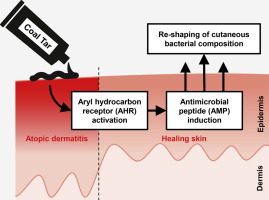当前位置:
X-MOL 学术
›
J. Invest. Dermatol.
›
论文详情
Our official English website, www.x-mol.net, welcomes your
feedback! (Note: you will need to create a separate account there.)
Targeting the Cutaneous Microbiota in Atopic Dermatitis by Coal Tar via AHR-Dependent Induction of Antimicrobial Peptides.
Journal of Investigative Dermatology ( IF 5.7 ) Pub Date : 2019-07-22 , DOI: 10.1016/j.jid.2019.06.142 Jos P H Smits 1 , Thomas H A Ederveen 2 , Gijs Rikken 1 , Noa J M van den Brink 1 , Ivonne M J J van Vlijmen-Willems 1 , Jos Boekhorst 3 , Marijke Kamsteeg 1 , Joost Schalkwijk 1 , Sacha A F T van Hijum 3 , Patrick L J M Zeeuwen 1 , Ellen H van den Bogaard 1
Journal of Investigative Dermatology ( IF 5.7 ) Pub Date : 2019-07-22 , DOI: 10.1016/j.jid.2019.06.142 Jos P H Smits 1 , Thomas H A Ederveen 2 , Gijs Rikken 1 , Noa J M van den Brink 1 , Ivonne M J J van Vlijmen-Willems 1 , Jos Boekhorst 3 , Marijke Kamsteeg 1 , Joost Schalkwijk 1 , Sacha A F T van Hijum 3 , Patrick L J M Zeeuwen 1 , Ellen H van den Bogaard 1
Affiliation

|
Skin colonization by Staphylococcus aureus and its relative abundance is associated with atopic dermatitis (AD) disease severity and treatment response. Low levels of antimicrobial peptides in AD skin may be related to the microbial dysbiosis. Therapeutic targeting of the skin microbiome and antimicrobial peptide expression can, therefore, restore skin homeostasis and combat AD. In this study, we analyzed the cutaneous microbiome composition in 7 patients with AD and 10 healthy volunteers upon topical coal tar or vehicle treatment. We implemented and validated a Staphylococcus-specific single-locus sequence typing approach combined with classic 16S ribosomal RNA marker gene sequencing to study the bacterial composition. During coal tar treatment, Staphylococcus abundance decreased, and Propionibacterium abundance increased, suggesting a shift of the microbiota composition toward that of healthy controls. We, furthermore, identified a hitherto unknown therapeutic mode of action of coal tar, namely the induction of keratinocyte-derived antimicrobial peptides via activation of the aryl hydrocarbon receptor. Restoring antimicrobial peptide levels in AD skin via aryl hydrocarbon receptor-dependent transcription regulation can be beneficial by creating a (anti)microbial milieu that is less prone to infection and inflammation. This underscores the importance of coal tar in the therapeutic aryl hydrocarbon receptor armamentarium and highlights the aryl hydrocarbon receptor as a target for drug development.
中文翻译:

煤焦油通过AHR依赖性抗菌肽诱导靶向特应性皮炎中的皮肤微生物群。
金黄色葡萄球菌引起的皮肤定植及其相对丰度与特应性皮炎(AD)疾病的严重程度和治疗反应有关。AD皮肤中抗菌肽水平低可能与微生物营养不良有关。因此,针对皮肤微生物组和抗菌肽表达的治疗目标可以恢复皮肤稳态并对抗AD。在这项研究中,我们分析了局部煤焦油或媒介物治疗后7例AD患者和10名健康志愿者的皮肤微生物组组成。我们实施并验证了一种葡萄球菌特异性单基因座序列分型方法,并结合经典的16S核糖体RNA标记基因测序来研究细菌组成。在煤焦油处理期间,葡萄球菌的丰度降低,丙酸杆菌的丰度增加,提示微生物群组成向健康对照组的转变。此外,我们确定了煤焦油迄今未知的治疗作用方式,即通过芳基烃受体的活化来诱导角质形成细胞衍生的抗菌肽。通过建立芳基烃受体依赖性的转录调节来恢复AD皮肤中的抗菌肽水平可以通过产生不易于感染和发炎的(抗)微生物环境而有益。这强调了煤焦油在治疗性芳基烃受体武器库中的重要性,并突出了芳基烃受体作为药物开发的目标。即通过芳基烃受体的活化来诱导角质形成细胞衍生的抗菌肽。通过建立芳基烃受体依赖性的转录调节来恢复AD皮肤中的抗菌肽水平可以通过产生不易于感染和发炎的(抗)微生物环境而有益。这强调了煤焦油在治疗性芳基烃受体武器库中的重要性,并突出了芳基烃受体作为药物开发的目标。即通过芳基烃受体的活化来诱导角质形成细胞衍生的抗菌肽。通过建立芳基烃受体依赖性的转录调节来恢复AD皮肤中的抗菌肽水平可以通过产生不易于感染和发炎的(抗)微生物环境而有益。这强调了煤焦油在治疗性芳基烃受体武器库中的重要性,并突出了芳基烃受体作为药物开发的目标。
更新日期:2020-01-22
中文翻译:

煤焦油通过AHR依赖性抗菌肽诱导靶向特应性皮炎中的皮肤微生物群。
金黄色葡萄球菌引起的皮肤定植及其相对丰度与特应性皮炎(AD)疾病的严重程度和治疗反应有关。AD皮肤中抗菌肽水平低可能与微生物营养不良有关。因此,针对皮肤微生物组和抗菌肽表达的治疗目标可以恢复皮肤稳态并对抗AD。在这项研究中,我们分析了局部煤焦油或媒介物治疗后7例AD患者和10名健康志愿者的皮肤微生物组组成。我们实施并验证了一种葡萄球菌特异性单基因座序列分型方法,并结合经典的16S核糖体RNA标记基因测序来研究细菌组成。在煤焦油处理期间,葡萄球菌的丰度降低,丙酸杆菌的丰度增加,提示微生物群组成向健康对照组的转变。此外,我们确定了煤焦油迄今未知的治疗作用方式,即通过芳基烃受体的活化来诱导角质形成细胞衍生的抗菌肽。通过建立芳基烃受体依赖性的转录调节来恢复AD皮肤中的抗菌肽水平可以通过产生不易于感染和发炎的(抗)微生物环境而有益。这强调了煤焦油在治疗性芳基烃受体武器库中的重要性,并突出了芳基烃受体作为药物开发的目标。即通过芳基烃受体的活化来诱导角质形成细胞衍生的抗菌肽。通过建立芳基烃受体依赖性的转录调节来恢复AD皮肤中的抗菌肽水平可以通过产生不易于感染和发炎的(抗)微生物环境而有益。这强调了煤焦油在治疗性芳基烃受体武器库中的重要性,并突出了芳基烃受体作为药物开发的目标。即通过芳基烃受体的活化来诱导角质形成细胞衍生的抗菌肽。通过建立芳基烃受体依赖性的转录调节来恢复AD皮肤中的抗菌肽水平可以通过产生不易于感染和发炎的(抗)微生物环境而有益。这强调了煤焦油在治疗性芳基烃受体武器库中的重要性,并突出了芳基烃受体作为药物开发的目标。











































 京公网安备 11010802027423号
京公网安备 11010802027423号